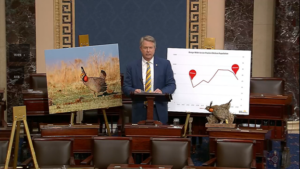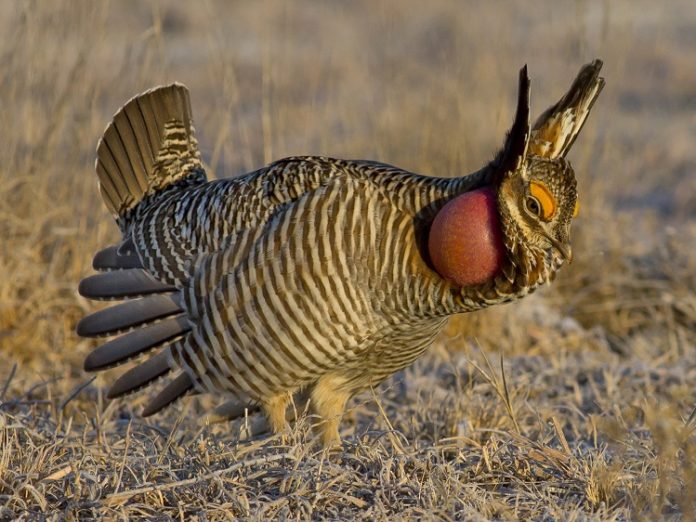The U.S. Senate late Wednesday afternoon narrowly passed a resolution that would block President Joe Biden’s administration from extending environmental protections to the lesser prairie chicken in Kansas and four other states.
The Senate voted 50-48 to pass the resolution backed by U.S. Sens. Roger Marshall and Jerry Moran that would strike down a rule issued by the U.S. Fish and Wildlife Service listing the bird as a protected species.
The resolution employs the Congressional Review Act to reverse the bird’s listing as protected under the Endangered Species Act, a move criticized as “legislating extinction.”
There is a similar bill in the House backed by 1st District Congressman Tracey Mann that passed out of the Natural Resources Committee last week.

Marshall said the Biden administration is overstepping its power under the Endangered Species Act by categorizing the bird as endangered or threatened even though he said its population in Kansas is considered stable.
Flanked by a picture of a lesser prairie chicken on one side and a mounted one on the other, Marshall said the U.S. Fish and Wildlife Service ignored years of conservation efforts when it decided to list the bird as protected under the law last November.
The Endangered Species Act was created in 1973 to protect species on the brink of extinction, Marshall said.
“Today, the consequences of this law reach far beyond its original intent,” he said.
“If saving species were the only consideration, then this administration wouldn’t be listing the lesser prairie chicken, whose population is considered stable in my home state of Kansas,” he said.
Marshall accused the Biden administration of using the Endangered Species Act to “attack rural America.”
“Make no mistake about it,” he said.
“The listing of any species adds more rules, more hoops to jump through, more time and cost from everyone, from our farmers and ranchers, our oil field workers, our utility lineman who are building new power poles and electric lines to get wind-generated electricity out to more populated states,” he said.
The Biden administration on Wednesday threatened to veto the resolution.
The Office of Administration and Budget issued a statement early in the day Wednesday ahead of the vote, vowing a veto if the resolution passed.
The agency noted that the rule protects a species of bird whose historical habitat on the Great Plains has diminished by about 90% and whose population has plummeted toward disappearance.
“The lesser prairie-chicken serves as an indicator for healthy grasslands and prairies, making them an important measure of the overall health of America’s grasslands, a treasured and storied landscape,” the agency said.
“Overturning common-sense protections for the lesser prairie-chicken would undermine America’s proud wildlife conservation traditions, risk the extinction of a once-abundant American bird,” the agency said.

Moran argued for more conservation efforts.
“Listing the bird as a threatened or endangered species is not the answer – plain and simple, we need more rainfall, not more regulation,” Moran said.
“I am confident there are ways to conserve the species without hindering economic development in rural communities, and I will continue to push for a voluntary solution.”
Stephanie Kurose, a senior policy specialist at the Center for Biological Diversity, said the Senate’s action was a vote to “condemn this bird to extinction.”
“After waiting three decades for protection, this beautiful dancing bird deserves a fighting chance at survival,” Kurose said.
“It’s heartbreaking that 50 senators care more about lining the pockets of industry cronies than saving an irreplaceable piece of natural heritage in the West.”
The lesser prairie chicken is a species of prairie grouse that occupies a five-state range including portions of Texas, New Mexico, Oklahoma, Kansas and Colorado.
Federal regulators divided up the region into where the bird would be considered “endangered” or “threatened.”
Fish and Wildlife listed the bird as “endangered” in eastern New Mexico and in the western part of the Texas Panhandle, where there are believed to be as few as 5,000 birds remaining, with the count dropping to as low as 1,000 birds in 2015.
The bird would be listed as “threatened” in south-central and southwestern Kansas, southeastern Colorado, western Oklahoma and the northeast Texas Panhandle.
Regulators said the prairie chicken is not currently in danger of extinction in those northern areas but is likely to become at risk of extinction within the foreseeable future throughout all of its range.
Former Kansas House Majority Leader Don Hineman, a longtime farmer and rancher from Dighton, recently testified before a House subcommittee against efforts to list the bird as endangered or threatened.
Hineman explained how there have been years of efforts to conserve the bird, causing its population to increase from 16,724 in 2013 to 36,278 in 2020.
Hineman explained how the population of the lesser prairie chicken tends to be “boom or bust” depending on the amount of rainfall.
There are two ongoing lawsuit challenging the listing, one brought in part by the Kansas Livestock Association and another brought by Texas, Oklahoma and Kansas.
This is the second time the federal government has run into a lawsuit after trying to extend protections to the lesser prairie chicken.
Eight years ago, the U.S. Fish and Wildlife Service listed the lesser prairie chicken as threatened under the Endangered Species Act.
However, a federal court set aside those protections after it found that the agency failed to properly evaluate the effect of voluntary conservation efforts to protect the bird.
This time, Republicans are trying to employ a legislative maneuver that’s been around since 1996 and was rarely used up until 2017, when the Republican-controlled Congress used it to reverse rules promulgated under President Barack Obama’s administration.
Since Biden was elected president, Democrats have turned to the strategy to reverse Donald Trump-era rules as well.
Enacted as part of the Small Business Regulatory Enforcement Fairness Act, the Congressional Review Act gives Congress more power over rules imposed by federal agencies.
A Congressional Review Act establishes a special set of parliamentary procedures for considering a resolution disapproving an agency’s final rule.
The procedures make it easier for Congress to pass a joint resolution rejecting the rules, particularly in the Senate where under certain circumstances it cannot be filibustered. A simple majority is needed for passage.
However, a Congressional Review Act must still be signed by the president, who has already threatened to veto the resolution.
Congress would need a two-thirds vote to override a veto of a Congressional Review Act similar to what’s proposed in the case of the lesser prairie chicken – another significant hurdle to passage considering it only got 50 votes in the Senate.
It is generally believed that Congressional Review Acts are outside the scope of judicial review as well.














